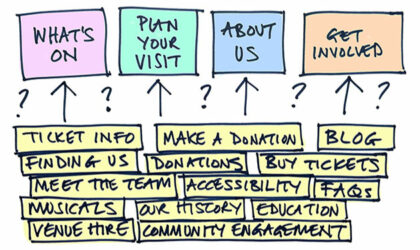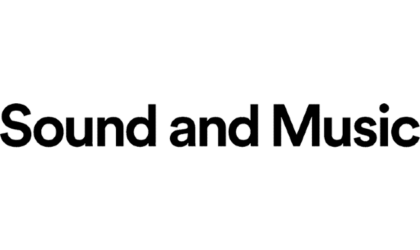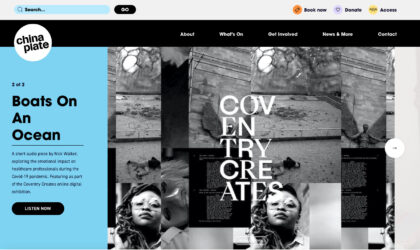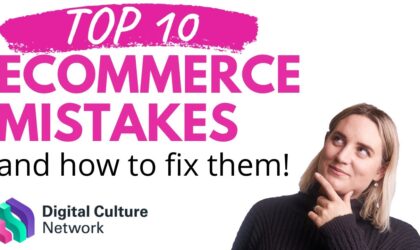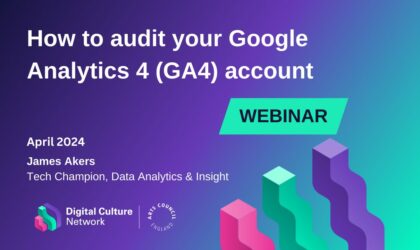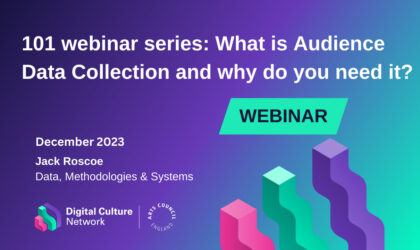
Beginner Read Audience Data Collection and Evaluation
Audience research is the process of gathering information about the people who visit you or see your work, use your services, or engage with your organisation.
Beginner Read Audience Data Collection and Evaluation
Audience research is the process of gathering information about the people who visit you or see your work, use your services, or engage with your organisation.
Beginner Read Digital Accessibility
The goal of digital accessibility is to create digital products and services that are inclusive and provide equal access to information and functionality to all users, regardless of their abilities. This article aims to introduce you to the principles of digital accessibility, and shed some light on some of the things you need to know when creating accessible digital content.
Beginner Read Digital Strategy
An effective digital strategy can be vital to your organisation’s success. Read on to understand the key considerations when developing yours.
Beginner Read Data Analytics and Insight
What can you learn from the data your organisation holds? Read on to understand how to get started on analysing your data and using it to effect positive change.
Beginner Read Email Marketing
Email marketing is a powerful tool when it comes to building relationships with your audience. Read on to find out more about what it can do for your organisation.
Beginner Read Digital Strategy Websites
Your website is one of your most important assets. Read on to find out how it can make a big impact on your organisation.
Beginner Read Video and Digital Content
Storytelling is the key to amazing content. Read on to understand how to incorporate great content into all facets of your digital marketing.
Beginner Read Box Office and Ticketing Customer Relationship Management CRM
Understanding your audience data can be your ticket to success. Read on to find out how to make the most of what your customers tell you.
Beginner Read Digital Marketing
Five recommendations to help improve your digital marketing performance.
Beginner Read Websites
Whether you're creating a brand-new site or reviewing your existing web presence completely, here are some recommendations for making your website as effective as possible.
Beginner Read Digital Strategy eCommerce and Merchandising
Thinking about setting up an online shop? Read on to understand the basics of eCommerce and how it could benefit your organisation.
Beginner Read Email Marketing
If you’re looking for ways to improve your email marketing strategy, this checklist will help you establish where you are now and where you could go next.
Beginner Read Digital Accessibility
There are so many advantages to creating content that is digitally accessible. Not only is it inclusive, it can help your content convert better as well as appear in relevant searches. For creative and cultural organisations, it's also a wonderful way to make sure you can reach your audiences. To help you get started we've created a simple diagnostic checklist for digital accessibility with links to further resources.
Beginner Read Digital Marketing
Digital marketing increasingly affects all departments of your organisation. Read on to learn more about the different approaches available.
Beginner Read Search Engine Optimisation
Search Engine Optimisation can be a valuable tool for boosting your organisation’s online presence. Read on to find out why.
Beginner Read Customer Relationship Management CRM
Your organisation’s Customer Relationship Management (CRM) system is a powerful tool, but when your data becomes muddied with duplicates or incomplete information, it throws a spanner into your organisational processes. Here are 5 simple ways to clean up your organisation’s CRM.
Beginner Read Digital Accessibility
There are so many different things that can affect the way we use and interact with digital content, it can be hard to know where to start. That’s why we have put together these simple tips for things you can do right away to help you improve the digital accessibility of your content.
This article is a best practice guide for creative and cultural organisations who want to manage and optimise their Google Business Profile.
Beginner Read Digital Accessibility
External Link
Coffee Break with Roberta our Digital Accessibility Tech ChampionIn this video, you'll learn all about Roberta - our Tech Champion for digital accessibility. With a broad career in tech, Roberta can support creative and cultural organisations and individuals to make their digital presence accessible.
Beginner Read
We often hear the same misconceptions and this article aims to unpick the myths you're likely to encounter whilst working on a digital project or more broadly in the sector.
Beginner Read Search Engine Optimisation
This article provides an overview of what Search Engine Optimisation (SEO) is, how it works, and how it can benefit your organisation.
Beginner Read Digital Accessibility
In terms of presentations, videos, training sessions, and public speaking, an easy way to increase accessibility and inclusivity is to 'self-describe'. Discover what self-describing is, why it is important, and how to do it effectively in this article.
Beginner Read Audience Data Collection and Evaluation
This article takes a deeper dive into the different methods for fieldwork and data collection to support these studies, and which ones are useful for different research objectives.
Beginner Read Audience Data Collection and Evaluation
There are many different types of audience research projects. In this article we’re going to take a look at a few types of research projects that creative and cultural organisations and individuals might carry out, and the research objectives that underpin them.
Beginner Read eCommerce and Merchandising
This article outlines the 11 most useful eCommerce metrics to help you understand your online shop and its performance.
Beginner Read Audience Data Collection and Evaluation
Audience surveys are a valuable tool for organisations that want to learn more about their target audience. These top tips should help you focus on what matters and get results.
How to choose the right keywords to improve your online visibility and website ranking.
Beginner Read Data Analytics and Insight Search Engine Optimisation Websites
This article is aimed at anyone who wants to improve the effectiveness of their website and improve the experience of their website visitors.
Beginner Read Data Analytics and Insight
Explore our top tips for embracing Data Analytics & Insight in your organisation.
Beginner Read Websites
Could your website be working harder for you? Our checklist will help you assess and improve your activities
Beginner Read Box Office and Ticketing Customer Relationship Management CRM
It's never been more important to ensure you are using technology that can immediately add value and grow with your organisation over the years. Understanding which companies to approach and how to articulate your requirements to them is a key step in making the right decision.
Beginner Read Customer Relationship Management CRM
Five tips for implementing a new Customer Relationship Management system to improve results all round.
Beginner Read Customer Relationship Management CRM
Customer Relationship Management is all about keeping the customer satisfied: our checklist will help you put them at the heart of your services.
Beginner Read Video and Digital Content
Here are five things to bear in mind when making your next video.
Beginner Read Email Marketing
Whether you already send emails regularly or you’re planning your very first campaign, these top tips will help you to plan your mail-outs and learn from them.
Beginner Read eCommerce and Merchandising
Are you missing out on sales? Our diagnostic will help you assess and improve your current strategy.
Beginner Read eCommerce and Merchandising Websites
Emma Roberts shares her top tips for embracing eCommerce and using a streamlined customer journey to generate more sales.
Beginner Read Digital Strategy
Do you have a good understanding of which parts of your digital strategy are working? Our diagnostic will help you assess and improve your activities.
Beginner Read Video and Digital Content
Looking for ways to make your content work harder for you? Our checklist will help you create more engaging material for your target audience.
Beginner Read Digital Strategy
These top tips will help you improve and develop your approach to digital strategy and planning.
Beginner Read Search Engine Marketing/ Search Engine Optimisation
Explore our step-by-step guide to auditing your Google Ads account and use it to optimise and enhance one of your essential tools.
Beginner Read Data Analytics and Insight
Do you have a good understanding of your organisation's data analytics tools? Our checklist will help you assess and improve your audience insight.
Beginner Read Video and Digital Content
External Link
Canva and Capcut: Getting started with free content creation toolsIn this comprehensive guide, we dive into the dynamic duo that will take your videos to the next level. Canva, the popular design platform, and Capcut, the powerful video editing app, join forces to unlock your creativity and revolutionise your visual content.
Beginner Read Email Marketing
When your email marketing campaign doesn’t perform as well as you need it to there are some simple questions to ask. This article gives you the 5 W’s to investigate why your campaign is not performing as expected: Who, What, When Where, and Why?
Beginner Read Data Analytics and Insight
In this article we explain the data in each reporting section of Google Analytics 4 and how those sections can be used to understand how your website is performing and what your users are doing.
Beginner Read Email Marketing
Personas are fictional representations of people within your audience or customer base. In this article, we explore how personas work where resources in terms of time and budgets are limited. If you don’t have time or money for a major project, this article will show you what a lo-fi, low-cost version of personas look like and how can creating personas add value.
Beginner Read eCommerce and Merchandising
This article shows that by developing a ‘Pull’ eCommerce strategy, an organisation can put itself in a strong position to grow revenues and attract more customers.
Beginner Read Websites
WordPress is the world’s most popular website platform, and is widely used by creative and cultural organisations. This article gives you 10 top tips to speed up your website.
Intermediate Read Digital Strategy
Do you often find yourself juggling 10 different tasks at once? Do you find you are not doing things as well as you know you could? This article will help you to streamline your marketing and redirect focus towards feasible and sustainable goals.
Beginner Read Email Marketing
Contact data is business critical and one of your organisation's most valuable assets. Find out how to set up and grow, and collect a contact database starting with these 5 essentials.
Beginner Read Websites
This article on sustainable websites provides a checklist of 10 things you or your organisation can do to reduce a digital carbon footprint.
Beginner Read Video and Digital Content
Keywords are an essential element of your video’s description or caption on any social media platform. Including relevant keywords can increase your views and engagement. In this article, we’ll explore how to choose keywords that will get your videos noticed by as wide an audience as possible.
Beginner Read Data Analytics and Insight
External Link
Coffee Break: Google Update: Big Changes to Google Analytics!Google is making some big changes to Google Analytics, which will affect how you track your website traffic. In this coffee break, our analytics Tech Champion James, explains the changes and how you can prepare for them. We also have a video tutorial that will walk you through the new features of Google Analytics 4!
Beginner Read
External Link
Coffee Break with Andy our Website Tech ChampionIn this video, you'll learn all about Andy - our Tech Champion for websites. With a broad career in tech, Andy can support creative and cultural organisations and individuals across a variety of website projects.
Beginner Read eCommerce and Merchandising
In this article, we explain what the customer journey is and how it can be used to structure an audit of your eCommerce website. Follow this approach, and you should be able to identify opportunities to improve your customer journey and grow online revenue.
Beginner Read Data Analytics and Insight
In this article, we explain the steps to set up and configure the digital analytics platform Google Analytics 4 with Spektrix to enhance your reporting with eCommerce data.
Beginner Read Video and Digital Content
Our Digital Content Tech Champion Dean, shares simple but crucial ways to create successful videos that are filmed quickly, efficiently, and edited, and uploaded in no time.
Beginner Read Data Analytics and Insight Digital Marketing
Excel is arguably the most powerful software at sorting data into meaningful categories and the go-to tool for most marketers and data analysts, particularly when it comes to reporting. This article will introduce you to ten functions, formulas and shortcuts to try next time you are manipulating your metrics.
Beginner Read Email Marketing
Want to improve your email marketing? Our health check will help you asses and improve you activities.
Beginner Read Websites
Are you a creative or cultural organisations looking to redesign or improve your website? This article helps you source and select the best supplier to do the job.
Beginner Read Data Analytics and Insight
In this article, we explore Google Looker Studio (formerly Google Data Studio) and how it can be used to create interactive and shareable reports to help you see how you are performing, if you're on track to reach your objectives, and identify opportunities for change.
Beginner Read Video and Digital Content
This resource will show you how to connect to your audience this festive season by using digital content on social media to create your marketing campaign
Intermediate Read Video and Digital Content
Looking for a cost-effective way to live-stream content to your audience? This article outlines how to stream from a basic Zoom account to YouTube, allowing you to harness the functionality of Zoom alongside the benefits of YouTube.
Beginner Read eCommerce and Merchandising
Did you know that the festive season can be a great opportunity for creative and cultural organisations and artists to generate online revenue? During December consumer spending leaps as many people celebrate Christmas, Hanukkah and other festivals with gift-giving and plenty of socialising. Read on to discover what you can do to get ready.
Beginner Read eCommerce and Merchandising
The festive period is a great time to drive online sales. In this article we'll explore how creative and cultural organisations can develop a winning eCommerce strategy for the the upcoming festivities.
Beginner Read eCommerce and Merchandising
We've put together a handy checklist of actions especially for creative and cultural individuals and organisations to improve eCommerce conversion during the festive period.
Beginner Read eCommerce and Merchandising
The build-up to Christmas is a busy online shopping period. In this article, creative and cultural individuals and organisations can learn about different types of promotions, key timings in the festive period and the ingredients of a successful online promotion.
Beginner Read eCommerce and Merchandising
This article focuses on how creative and cultural individuals and organisations can keep customer service running smoothly during the festive period. The run-up to Christmas is a busy time for shopping online and in this article we highlight 5 best practice tips to pro-actively manage communications with your customers and minimise workload for your customer service team.
Beginner Read Digital Strategy
This article aims to provide compelling reasons why creative and cultural organisations and individuals should continue to put emphasis on their digital strategy so that they can adapt to change and drive better results.
Intermediate Read Data Analytics and Insight Digital Marketing
In this article we explain what UTM Parameters are and why they're useful for creative and cultural organisations and individuals to consider using.
Beginner Read Digital Strategy
Cyber security is a critical, yet often overlooked, aspect of your strategy. Understanding what you and your organisation can do to protect your online and off-line systems and networks will help protect your data from theft and damage. In this article we'll explore how you can protect yourself and your organisation.
Beginner Read Data Analytics and Insight
Google Analytics 4 is the brand new web analytics platform from Google. This article explains what it is, the key differences to the old Google Analytics version, and how arts and culture organisations could utilise it.
Beginner Read eCommerce and Merchandising
In this introduction we explore NFTs and explain how they might be relevant to arts and cultural organisations.
Beginner Read Box Office and Ticketing
This resource provides information and advice on implementing a timed entry booking system into your organisation, from choosing the right technology platform to introducing ticketing to your website.
Intermediate Read Box Office and Ticketing Customer Relationship Management CRM
G-Cloud can be a useful tool in your hunt and planning for procurement for your next ticketing or CRM system. Read on to find out how.
Intermediate Read Digital Strategy
The role of prioritisation tools has become increasingly vital for creative and cultural organisations. This article explores the Value vs Effort, The Kano Model, and MoSCoW methods and how these tools can support more efficient and effective marketing plans.
Beginner Read Digital Accessibility
In this interview with Joe Strickland we take a look at the innovative work being done by DaDa with digital accessibility and 3D holographic technology.
This is the second case study in our Digital Journeys series, where we delve into the success stories of creative and cultural organisations and individuals who have received long-term support from the Digital Culture Network.
Beginner Read Case Studies
Welcome to the first case study in our Digital Journeys series, where we delve into the success stories of creative and cultural organisations and individuals who have received long-term support from the Digital Culture Network.
Beginner Read Case Studies Digital Strategy eCommerce and Merchandising
We The Curious produced a sustainable and successful online revenue stream with their charitable aims at the centre of their decision-making. Find out more about their 'Income Generation' category winning online shop.
Meet 'Digital Inclusion' category Winners Sense and learn about their inclusive dance film 'Moving Portraits', made in collaboration with dancers who are deafblind and/or are living with complex disabilities.
Learn about Julie Nicholson and her work at Digital Voice to amplify the voices of marginalised people and groups. Julie was named the 'Digital Ambassador' category Winner for the DigitalMe project.
Beginner Read Case Studies Video and Digital Content
Learn about Sonzai, Roland Lane’s 'Content Creator' winning Mixed Reality installation experience that uses cutting-edge immersive technology to blur the lines between physical & virtual worlds.
Beginner Read Case Studies Data Analytics and Insight Digital Strategy
Learn how 'Using Data' category Winners Watershed developed new data-informed inclusion strategies by embracing a new framework for data collection & analysis.
Learn more about DaDa’s 'Digital Transformation' winning research & development project, which explored the use of augmented reality holograms to provide BSL interpretation for non-traditional theatre.
Beginner Read Case Studies Websites
Raising2Children is an online resource for parents, children, young people, and colleagues that supports families. Raising2Children create resources that bring together evidence-based research on child development and therapeutic tools using the arts. Click here to find out how Cultural Digital Network helped rework their website.
Beginner Read Case Studies
DanceEast is a dance organisation based in Ipswich, working locally, regionally and nationally. Lucy Bayliss, their Head of Creative Programmes, tells us how they employed digital technology to get their dance programmes into classrooms.
Beginner Read Case Studies
Winners of the Content Creation & Distribution category at the 2022 Digital Culture Awards, the Old Vic, tell the story of their ‘OLD VIC: IN CAMERA’ project.
Beginner Read Case Studies Digital Strategy
Winners of a Special Commendation for the impact of their digital content distribution strategy at the 2022 Digital Culture Awards, Open Clasp Theatre Company tell the story of their ‘Changing the World One Play at a Time’ project.
Beginner Read Case Studies Digital Strategy
Open Sky, winners of the 2022 Digital Culture Award Digital Inclusion category for their ‘Micro Plays’ project, tell us their winning story.
Beginner Read Case Studies Digital Strategy
National Student Drama Festival, winners of the 2022 Digital Culture Awards Digital Trailblazer category, tell us their winning story of expanding their reach with digital transformation.
Beginner Read Case Studies Data Analytics and Insight
Join Sound and Music, winners of the 2022 Digital Culture Award Data Driven category, as they tell their winning story about using data to understand engagement barriers and create new music.
Beginner Read Case Studies Digital Strategy Video and Digital Content
Opera North, winners of the 2022 Digital Culture Awards Income Generation category for their 'Couch to Chorus' project, take us on their award-winning journey.
Beginner Read Email Marketing Digital Strategy
Join Head of Retail at BALTIC Centre for Contemporary Art, Sara Ley, as she tells us how an online shop strategy prompted a look at their wider marketing strategy.
Beginner Read Case Studies
The Foundling Museum believes in creative action transforming lives, to stimulate imaginations and enrich young lives. Museum Director Caro Howell explains how the museum navigated a hybrid digital/analogue approach in order to support and inspire its network of volunteers and young care-leavers after the advent of Covid-19.
Beginner Read Case Studies eCommerce and Merchandising
The Museum of London is in a central London location and tells the story of Londoners from prehistoric times to the present day. The Museum of London Docklands gives the history of the London docks. Join Buying and Merchandising Manager Rita Rooney as she explains how the museum redeveloped their eCommerce strategy with the support of the Digital Culture Network. Case study from February 2021.
Beginner Read Case Studies Websites
Higher Rhythm Ltd is a not-for-profit organisation based in Yorkshire, providing music and media industry services and opportunities across the Yorkshire region. Click here to find out how the Digital Culture Network's Roberta Beattie supported their CEO, Steven Mundin, in redefining the organisation's vision for its new website.
Beginner Read Case Studies Websites
Mythstories is a museum based in Shrewsbury that holds a collection of storytelling artefacts and a library of folktales. For over 20 years the museum has organised funded projects with storytelling at their heart. Much of their work is out of doors, much is with young people – encouraging them to explore the oral heritage and become young storytellers. Read on to find out how the Digital Culture Network helped rework their website.
Beginner Read Case Studies Digital Strategy Video and Digital Content
Little Angel Theatre is a children's theatre dedicated to fuelling the imagination through the art of puppetry. Marketing and Communications Manager, Sophie Waddy, explains how the Digital Culture Network helped them to rethink their digital strategy.
Beginner Read Case Studies eCommerce and Merchandising
Hospital Rooms was one of the most impressive digital stories the Digital Culture Network heard in 2020: a six-week digital fundraising campaign which raised £30,000 in print sales, and resulted in a 300% increase in memberships and 3,387% increase in website traffic. Project Curator Natalie Tilbury takes us through this case study from July 2020.
Beginner Read Case Studies Customer Relationship Management CRM eCommerce and Merchandising Video and Digital Content Websites
Open Sky Theatre is a small theatre company with big ideas based in rural Herefordshire, combining new writing with physical and digital theatre to tell powerful, moving stories based on real world events. Read on to find out how the Digital Culture Network supported Open Sky's Digital Director, Lisle Turner, in reimagining the organisation's digital strategy. Case study from December 2020.
Beginner Read Case Studies Websites
Impact Dance's main focus is to empower young people of diverse backgrounds through hip-hop dance training, mentoring, and national and international performances. Marketing and Communications Officer Clara Cowen talks us through how the London theatre company was supported by the Digital Culture Network to develop its website.
Beginner Read Case Studies Websites
Launched in 2006, China Plate are an independent theatre studio that work with artists, venues and festivals to develop, make and present engaging, entertaining and accessible new work. Read on to find out how the Digital Culture Network supported China Plate with the redevelopment of their website.
Beginner Read Case Studies eCommerce and Merchandising
Join us for an interview with Camilla Stewart, Head of Commercial Programmes and Collection Partnerships at Art UK, as she explains how the organisation has grown its online shop and dealt with lockdown. The interview took place in July 2020.
Beginner Read Search Engine Optimisation
This resource concentrates on tips and ideas to help organisations improve the visibility of their websites on Google Search Results Page (SERP). The resource is particularly suited to organisations and individuals within the creative and cultural sector.
Beginner Read Digital Accessibility
When creating work for the public, you’ve got a responsibility to make sure everyone can use it the way you intended them to. This article will detail step-by-step how to create an accessibility statement for your website.
Beginner Read Websites
This guide details the steps you can take to design your website.
Beginner Read Websites
Writing a brief for a web design project can be a daunting task. This article helps you break down your project and navigate this process.
Beginner Read Websites
A template that you can use as the basis to create your own website brief for web design agencies.
Intermediate Read Email Marketing
In this article, you’ll learn about what email engagement is and some ideas for tracking engagement over time. This will help you build a picture of what resonates with your audience so you can build up a healthy relationship with your email subscribers.
Beginner Read eCommerce and Merchandising
In this article we review 7 leading eCommerce platforms which are helping arts and cultural organisations pivot to online. We examine the usability, features, level of support, reporting and pricing structures for each platform. You'll also find examples of arts and cultural organisations using these platforms for reference.
Beginner Read Search Engine Optimisation
Previous SEO Tech Champion, Hansel, for an overview of exactly what we mean by Search Engine Optimisation. Be inspired to develop new strategies for improving the quality of your website traffic.
Beginner Read eCommerce and Merchandising
Introduction to how organisations can utilise Teemill, an online platform that allows users to build an online shop and sell their designs. Read on to find out what our Tech Champion, Emma Roberts, learned when speaking with Teemill's Head of Business Development, Tobias Penner.
Beginner Read Email Marketing
Are you looking to get more results from your email marketing? Creating and completing these templates will help you determine your objectives, write effective calls to action and deliver content that your audience will love.
Beginner Read eCommerce and Merchandising
Emma Roberts, Tech Champion for eCommerce and merchandising, talks through 10 common eCommerce mistakes to avoid when selling online - and ways to fix them.
Beginner Read Email Marketing
Are you about to start using a new email service provider? Or is your mailing list in a bit of a mess? Read on for some top tips for structuring and segmenting your mailing list.
Beginner Read Video and Digital Content
Working from home and need to create videos using the equipment you already have? This video explains how you can make professional looking content using only a mobile phone.
Beginner Read Video and Digital Content
Looking for ways to earn revenue from your live streams? In this video, we take a quick look at Crowdcast, a solution that has enabled many artists and musicians to continue earning money whilst in lockdown.
Beginner Read Video and Digital Content
This resource provides information and advice on making video content using a smartphone. As well as considerations for generating content, it contains advice on hardware, software and distribution.
Beginner Read Websites
SSL Security certificates play an important role in protecting your website. So, what are they and how do you get the right one for your website? This article will tell you all you need to know.
Beginner Read Digital Accessibility Websites
Learn how to make different forms of digital content accessible to all audience members and what steps you can take to make the experience for your audience as good as it can be, to ensure their needs are accounted for on different platforms.
Beginner Read Audience Data Collection and Evaluation
This article will help you to understand the accuracy of survey data, setting survey targets, and how to make your data more representative.
Beginner Read Webinars Data Analytics and Insight
A webinar for those working in the creative and culture sector to review their Google Analytics 4 set up and build confidence in their data.
A webinar for creative and cultural organisations to learn how to perform a simple health check on their website to highlight improvements.
Beginner Read Webinars Email Marketing
A webinar for creative and cultural organisations and individuals to learn how GDPR/PECR regulations can support your email marketing and help you grow your contact list.
Beginner Read Webinars eCommerce and Merchandising
A webinar for organisations and individuals with online shops, to learn how to grow their eCommerce sales with best practice online merchandising.
Beginner Read Webinars Audience Data Collection and Evaluation
A webinar to introduce creative and culture organisations to audience data collection and research.
Beginner Read Webinars Digital Accessibility
A webinar to introduce creative and culture organisations to digital accessibility and the role it plays in creating successful content.
Beginner Read Webinars Search Engine Optimisation
Discover practical approaches to SEO for the cultural sector, including increasing visibility and leveraging Google’s rich results.


























